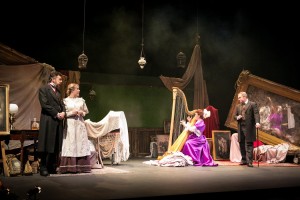Being not too far away from the ruined Margam Abbey, frequently visited by photography pioneer Henry Fox Talbot, added another frisson of interest to Mappa Mundi Theatre’s spooky show Still Life with its central theme of capturing images of the living and dead.
One of the surviving photographs by Henry Fox Talbot, whose cousin owned Margam Abbey which was also frozen in time by the new scientific image-capturing innovation, is of his half-sister playing the harp. The fate of a beautiful young harpist photographed by the central character of this story of obsession told through ghost stories is the opening shivers-inducing tale. Spooky.
In fact, in that image is a smudge (or is it?). This features in another of the stories which our narrator wonders is the soul of the departed leaving the body of the dead person. With clever tricks that would have blown the socks off the early photographers that smudge develops into a screaming face. Even spookier.
Gwawr Loader
I should imagine these are coincidences as Still Life, written by Keiron Self, is based on the imaginings of Edgar Allan Poe and M R James but they are in keeping with the play’s fusing of historical fact, the development of photography and the Victorian’s obsession with death, the after-life and, most creepily, the fashion for taking photographs of the recently departed (or even digging up not so recently departed to pose for the camera), Memento Mori.
The play starts and ends with the narrator and progresses into his relationship with his wife, and his growing obsession with not only photography but how it can be used to capture the soul as the person passes from life to death. Naturally, or should that be supernaturally, this obsession leads to not only macabre episodes including the murder of that harpist and a grizzly execution by electric chair but in his own life and that of his wife.
This is the latest collaboration between Mappa Mundi Theatre and Theatr Mwldan is directed with elegance by Lynne Seymour with lovely atmospheric music from Dyfan Jones and Peter Knight and lighting by Ceri James.
Keiron Self and Francoise Pandolfo
Designer Carl Davies gives us a beautifully gothic creation in itself as well as becoming literally part of the action, whether that being the vast gilt mirrors and frames – and even back wall – that become part of those scary stories and there are plenty of jumps for the audience. The Victorian drawing room/study of the narrator becomes the setting for the stories, one of the most effective being the theatre in which the mysterious Italian clown and his dumb comedic fall guy who curses the theatre owner with, yes, you’ve guest, it horrific consequences.
We are addressed by the narrator as if we are the audience of a quasi-scientific lecture interspersed by the ghost stories which are either biographical, tracing the narrator and his wife’s life, or case studies for the lecture.
Richard Nichols, Lizzie Rogan, Gwawr Loader and Keiron Self
Richard Nicholas and Lizzie Rogan are the backbone of the work as the photographer/narrator and his wife, Gwawr Loader, Francoise Pandolfo and Keiron Self take the wildly contrasting other roles from that nasty clown and victim fall guy and the exquisite harpist to a father punished for his lack of paternal care and enthusiastic tourist who pays the price for blowing the whistle on the past.
Main image: Richard Nichols
Taliesin, Swansea. Further performances at Aberystywth and Brecon until October 23.
mappa-mundi.org.uk/



